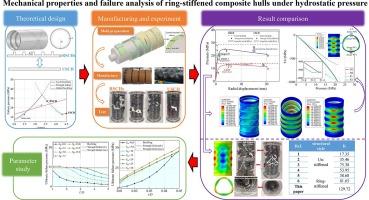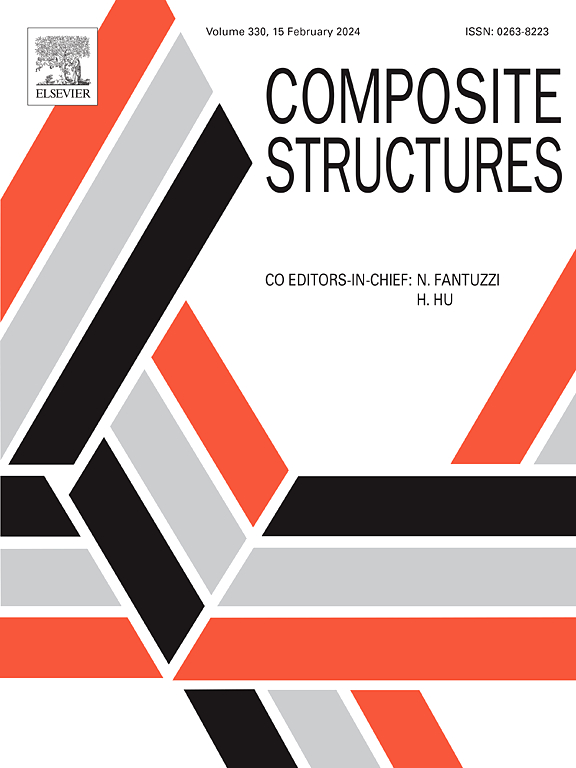Mechanical properties and failure analysis of ring-stiffened composite hulls under hydrostatic pressure
IF 6.3
2区 材料科学
Q1 MATERIALS SCIENCE, COMPOSITES
引用次数: 0
Abstract
Ring stiffeners improve the buckling resistance of thin-walled hulls. In this study, theoretical models of buckling and strength failure of ring-stiffened composite hulls (RSCHs) were used to determine the design parameters. The hulls were prepared by filament winding on a mould composed of multi-petal-combined foams and steel shafts. The experimental results showed that the hydrostatic bearing performance of RSCHs was 1.79 times that of an unstiffened composite hull (USCH) with the same weight-to-displacement ratio (WDR). The crack in the damaged stiffened hulls penetrated the entire axis and expanded circumferentially, resulting in a stiffener fracture. Imperfections related to thickness deviations were introduced into a nonlinear buckling model by considering progressive damage. In contrast to the failure mechanism of USCH, the failure pressure of RSCHs was not at the peak of nonlinear buckling, and fibre compressive failure at 90° on the outermost layer of the skin was dominant. The error between simulated and experimental results was 4.64 %. The parameter analysis indicated that the stiffener height and width had different effects on the buckling load. However, when only the same type of strength failure occurred, both were independent of the load. This study demonstrated the load-bearing advantages of RSCHs for ocean engineering applications.

静水压力下环形加固复合材料船体的力学性能和失效分析
环形加劲件可提高薄壁船体的抗屈曲性能。本研究采用环形加劲复合材料船体(RSCH)屈曲和强度破坏的理论模型来确定设计参数。船体是通过在由多瓣组合泡沫和钢轴组成的模具上缠绕长丝制备而成的。实验结果表明,在重量-位移比(WDR)相同的情况下,RSCH 的静水承载性能是非加劲复合材料船体(USCH)的 1.79 倍。受损的加劲船体上的裂缝贯穿整个轴线并向周向扩展,导致加劲件断裂。通过考虑渐进损伤,将与厚度偏差有关的缺陷引入非线性屈曲模型。与 USCH 的破坏机制不同,RSCH 的破坏压力并不处于非线性屈曲的峰值,在表皮最外层 90° 处的纤维压缩破坏占主导地位。模拟结果与实验结果的误差为 4.64%。参数分析表明,加强筋的高度和宽度对屈曲载荷有不同的影响。然而,当仅发生同一类型的强度破坏时,两者都与载荷无关。这项研究证明了 RSCH 在海洋工程应用中的承重优势。
本文章由计算机程序翻译,如有差异,请以英文原文为准。
求助全文
约1分钟内获得全文
求助全文
来源期刊

Composite Structures
工程技术-材料科学:复合
CiteScore
12.00
自引率
12.70%
发文量
1246
审稿时长
78 days
期刊介绍:
The past few decades have seen outstanding advances in the use of composite materials in structural applications. There can be little doubt that, within engineering circles, composites have revolutionised traditional design concepts and made possible an unparalleled range of new and exciting possibilities as viable materials for construction. Composite Structures, an International Journal, disseminates knowledge between users, manufacturers, designers and researchers involved in structures or structural components manufactured using composite materials.
The journal publishes papers which contribute to knowledge in the use of composite materials in engineering structures. Papers deal with design, research and development studies, experimental investigations, theoretical analysis and fabrication techniques relevant to the application of composites in load-bearing components for assemblies, ranging from individual components such as plates and shells to complete composite structures.
 求助内容:
求助内容: 应助结果提醒方式:
应助结果提醒方式:


